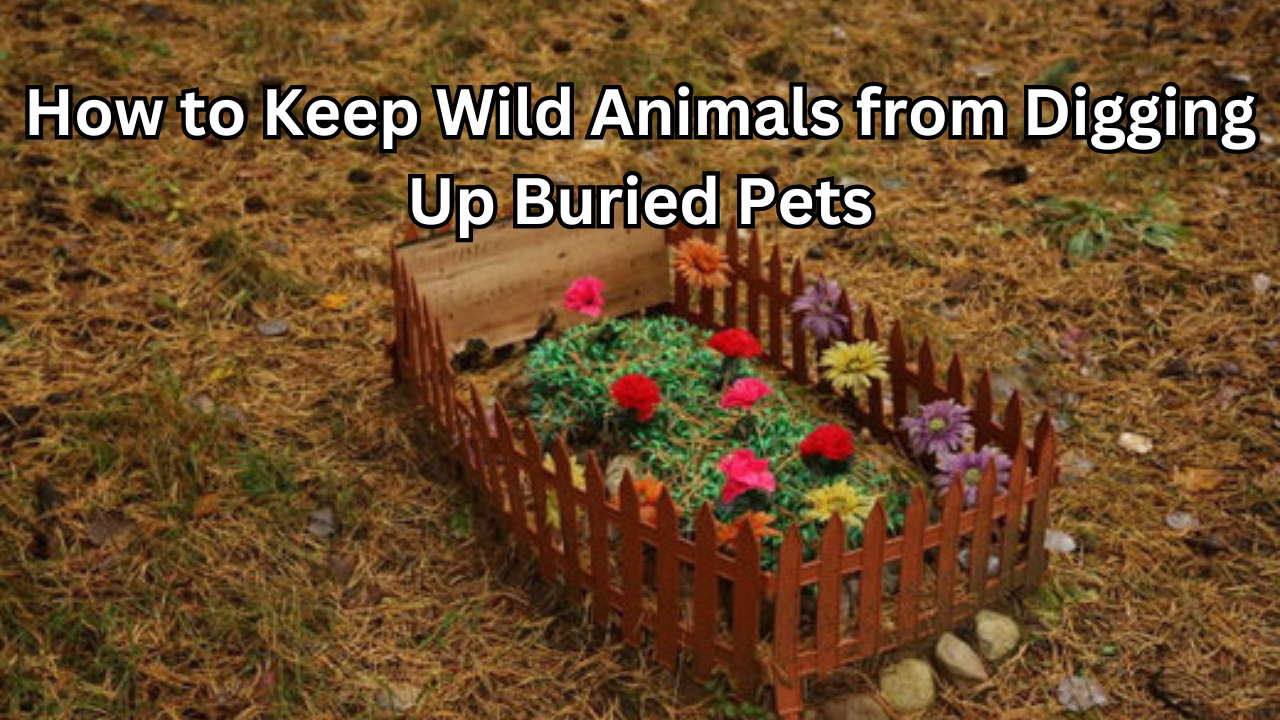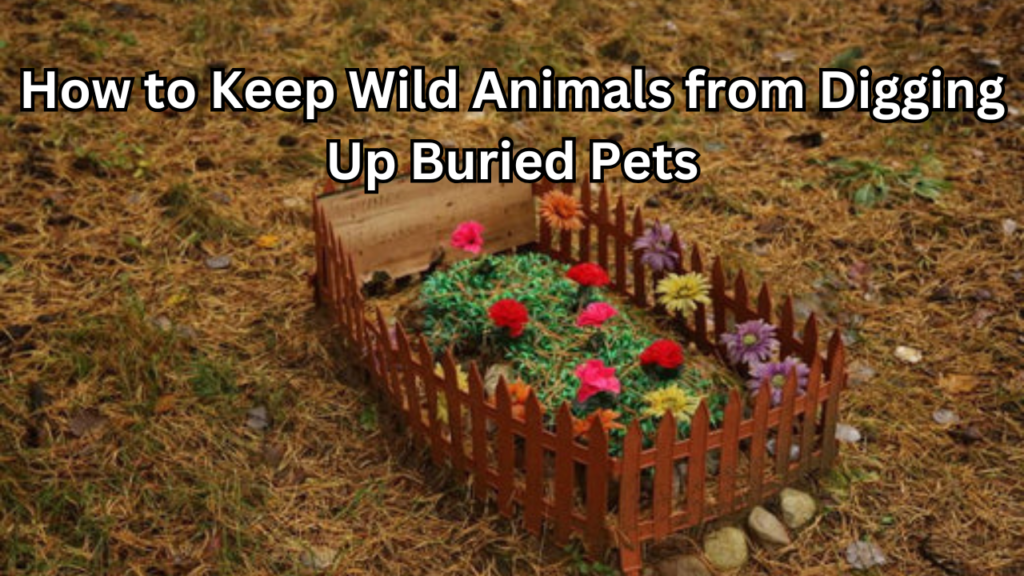

Table of Contents
Introduction
Losing a beloved pet is never easy, and when it comes time to say goodbye, many pet owners opt for a private burial in their yard or garden. However, an unexpected challenge can arise when wild animals, such as raccoons, coyotes, or even domestic dogs, begin digging up the burial site. These animals are often attracted to the scent of the pet and may disturb the grave, causing distress to the grieving family. Learning how to keep wild animals from digging up buried pets is essential for ensuring that your pet’s final resting place remains undisturbed.
Proper pet burial is crucial not only for emotional closure but also for the protection and respect of your pet’s remains. With the right precautions in place, you can prevent wildlife from interfering with your pet’s burial site, offering peace of mind and protecting the integrity of your burial. In this article, we will explore practical tips and strategies to help you safeguard your pet’s resting place from the curiosity and habits of wild animals.
Why Wild Animals Dig Up Buried Pets
Wild animals, particularly scavengers, have natural instincts that drive them to dig up buried animals. Their behavior is primarily motivated by the scent of decomposing matter, which they associate with a potential food source. Many of these creatures rely on scavenging to survive, often seeking out carcasses of deceased animals to sustain themselves. When a pet is buried, its scent can travel underground, attracting animals such as foxes, coyotes, raccoons, and even domestic pets and animals like cats. Understanding what animal will dig up dead animals helps in determining the best methods to protect your pet’s burial site.
Common culprits include foxes, who are opportunistic scavengers, and raccoons, known for their curious nature and adept digging abilities. Coyotes, being skilled hunters and scavengers, are also likely to dig up a buried pet if the scent reaches them. Many pet owners wonder, “Will coyotes dig up dead animals?” The answer is yes—coyotes are particularly known for digging up carcasses, as they have an acute sense of smell and will often disturb burial sites in search of food.
Additionally, while not as common, domestic cats might sometimes dig up small remains out of instinct or curiosity. Though do cats dig up dead animals as often as larger animals, they may still be attracted to the scent, especially in areas where they roam freely.
Understanding the behavior of these animals and their natural instincts can help you better prepare your pet’s burial site and minimize the risk of disturbance.
Why Is It Illegal to Bury Your Pet in Your Backyard?
While burying a pet in your backyard might seem like a simple and heartfelt way to say goodbye, it is important to understand that in many areas, it may be illegal to do so. The primary concerns revolve around legal regulations and environmental impacts. Why is it illegal to bury your pet in your backyard? In many places, local laws restrict pet burial to ensure proper handling of deceased animals and to prevent potential environmental hazards.
From a legal standpoint, pet burials are regulated to protect public health and the environment. When a pet is buried in an unregulated manner, there are risks of contamination, particularly if the pet was carrying disease or if its remains contaminate the groundwater. In some areas, permits are required for proper burial, and these rules help prevent improper disposal of animal remains. Additionally, if you live in an area with high water tables, or if you’re in a densely populated neighborhood, burial may not be permitted due to concerns about contamination or interference with local infrastructure.
Environmental implications are also significant. A pet buried improperly can affect the soil, plants, and surrounding wildlife. Without proper depth, the remains may attract scavengers and disrupt the natural ecosystem. For these reasons, it is crucial to check local regulations before deciding on a burial site for your pet. In many cases, you may be required to use a professional pet cremation or burial service to ensure compliance with the law and environmental safety.
How to Prevent Wild Animals from Digging Up Buried Pets
When burying a pet in your yard, taking the right precautions can help prevent wild animals from disturbing the grave. Proper burial techniques and deterrents can make a significant difference in protecting your pet’s final resting place. Here are some effective strategies for keeping wild animals at bay.
Burying Depth and Techniques to Deter Digging
One of the most important factors in preventing wild animals from digging up buried pets is the depth of the burial. A general guideline is to bury your pet at least 3 to 4 feet deep, ensuring that the scent is less detectable by scavengers. In addition to depth, consider creating a sturdy burial site by lining the grave with concrete or a similar hard material to discourage animals from digging. For those wondering how to stop foxes digging up buried pets, a deeper and well-covered burial is key, as foxes are particularly adept at sniffing out and digging into shallow graves.
Materials to Use for Covering the Burial Site
Covering the burial site with the right materials can also help deter wild animals. After burying your pet, place a heavy layer of rocks, large stones, or bricks over the grave. This will not only act as a physical barrier to discourage digging but also make it difficult for animals to access the scent. Additionally, placing a thick layer of mulch or soil over the burial site can help camouflage the area, making it less attractive to curious creatures. The more difficult it is for wild animals to access the remains, the better protected your pet’s burial site will be.
Natural Deterrents and Animal Repellents
In addition to physical barriers, natural deterrents can help keep wild animals from attempting to dig up a grave. Strong-smelling substances, such as vinegar, garlic, or predator urine (like that of coyotes or wolves), can act as natural repellents. Sprinkling these around the burial site may make the area less appealing to scavengers. Commercial animal repellents, available at most garden or home improvement stores, can also be effective in deterring animals like raccoons, foxes, and coyotes from approaching the site. If you’re asking how to stop foxes digging up buried pets, using fox repellent sprays or scents specifically designed to deter them may be particularly useful.
By combining these methods, you can significantly reduce the likelihood of wild animals disturbing your pet’s burial site, ensuring your pet rests peacefully without interference.
Proper Pet Burial Techniques
Burying a pet is an emotional process, and it’s important to do so in a way that respects both the animal and the environment. Whether you are burying a dog, cat, rabbit, or another pet, there are specific guidelines and best practices to follow. These techniques not only ensure that your pet’s remains are properly cared for but also help prevent issues like scavenging by wild animals.
How to Bury a Dog After Euthanasia
When burying a dog after euthanasia, it’s important to consider both emotional and practical aspects. After the procedure, allow the body to cool before proceeding with burial, as this can help prevent odors from developing. How to bury a dog after euthanasia involves ensuring the grave is deep enough to keep the body safely buried. Typically, you should dig a hole that is at least 3 to 4 feet deep. This will help deter scavengers and prevent any unpleasant odors from escaping. Placing the dog in a biodegradable bag before burial can also help protect the environment while allowing for natural decomposition. It’s also important to check local regulations, as some areas may have specific requirements for pet burial, such as obtaining a permit or using a specific type of grave marker.
Safe Practices for Burying Different Types of Pets
The burial process for different pets may vary slightly due to their size, weight, and specific needs. For example, when burying smaller pets like cats or rabbits, the grave doesn’t need to be as deep as for larger animals, but it still should be deep enough to prevent scavengers from digging it up. When you’re asking how deep to bury a pet rabbit, a depth of 2 to 3 feet is generally sufficient. Smaller animals like rabbits and cats also benefit from being buried in sturdy containers or wrapped in a cloth to help prevent decomposition odors from escaping. If you have a larger animal, such as a dog, ensure that you use heavier materials, like large stones, to cover the grave and make it harder for wild animals to interfere.
Will a Buried Dog Smell?
Many pet owners wonder if a buried dog will smell. When done correctly, with the proper depth and coverage, the answer is no. Decomposition may produce odors, but if the pet is buried at a sufficient depth, with a sturdy covering of dirt and rocks, the smells should stay contained. A well-buried dog, especially if wrapped in a biodegradable material, will decompose in a natural way without creating a noticeable odor. However, if the grave is too shallow or the burial is improperly done, there could be issues with smell and wildlife disturbance.
By following these guidelines, you can ensure a respectful, safe, and effective burial for your pet, offering peace of mind during a difficult time.
Will a Buried Pet Decompose and Emit Odors?
When burying a pet, it’s natural to wonder about the decomposition process and whether it will lead to unpleasant odors or attract wildlife. Understanding what to expect during this process can help you manage the burial site and ensure your pet’s final resting place remains undisturbed.
What to Expect When Burying Pets and Decomposition Rates
Decomposition is a natural part of life, and when a pet is buried, the body will gradually break down over time. The rate of decomposition depends on several factors, including the pet’s size, the burial depth, and environmental conditions like temperature and soil type. Generally, the decomposition process will take several months to a few years. Larger animals, like dogs, may take longer to decompose compared to smaller pets like cats or rabbits. While this natural breakdown happens underground, some pet owners worry about potential odors. Will a buried dog smell? If the burial is done correctly—at a sufficient depth, with proper covering and the use of biodegradable materials—the odors should stay contained. However, if the grave is too shallow or not sealed properly, there is a higher chance that decomposition gases and smells could escape.
How to Minimize Odors and Attractants for Wildlife
To minimize odors and prevent wildlife from being attracted to the burial site, it is essential to bury the pet at the right depth. A grave that is at least 3 to 4 feet deep for a dog can help trap odors underground and reduce the risk of scavengers being drawn to the site. Adding a layer of large rocks, stones, or bricks over the burial site can also help seal in the grave, preventing smells from reaching the surface. Additionally, sprinkling natural deterrents such as vinegar, garlic, or predator urine around the area can help keep wildlife away from the site. This not only reduces the risk of odors but also protects your pet’s final resting place from being disturbed by animals like raccoons, foxes, and coyotes.
By following these practices, you can ensure that your pet’s burial site remains undisturbed, while minimizing odors and any potential attraction for wildlife.
Conclusion
Securing a pet burial from wildlife is an essential part of ensuring that your beloved companion rests peacefully without the risk of being disturbed by scavengers. Proper burial techniques, such as ensuring the correct depth, using physical barriers, and applying natural deterrents, are critical in how to keep wild animals from digging up buried pets. By following these steps, you can help preserve the sanctity of the burial site while minimizing the chance of wild animals interfering with it.
For peace of mind, always remember to bury your pet at a sufficient depth, cover the grave with sturdy materials, and consider using natural animal repellents to deter potential threats. These simple precautions can provide the reassurance you need during a difficult time.
Taking the proper steps to protect pet burials from wild animals is a loving and respectful way to say goodbye. By securing your pet’s final resting place, you ensure that their memory is honored in the most peaceful and undisturbed way possible. So, if you’re planning a pet burial, be sure to implement these methods to effectively protect your pet’s grave and prevent wildlife from causing further disturbance.
FAQs
What stops animals from digging up dead animals?
Animals, especially scavengers, are often attracted to the scent of decomposing bodies. To stop them from digging up dead animals, the best approach is to ensure the burial is deep enough to contain the scent. Using physical barriers such as large rocks, bricks, or even concrete can help block access to the buried remains. Additionally, using natural deterrents like vinegar, garlic, or predator urine can discourage animals from approaching the burial site. These methods are effective in how to keep wild animals from digging up buried pets.
How do you keep animals from digging up buried pets?
To prevent animals from digging up a buried pet, you should follow several key steps. First, ensure the burial site is at least 3 to 4 feet deep, as this will help keep the scent of the pet contained underground. After burying the pet, cover the grave with large rocks or bricks to create a physical barrier. You can also apply animal repellents, such as predator urine or strong-smelling substances like garlic, around the area to deter wildlife. Proper burial techniques are essential for how to keep wild animals from digging up buried pets.
How long does a buried pet take to decompose?
The decomposition rate of a buried pet varies depending on factors such as the pet’s size, the soil’s moisture and temperature, and whether the burial was deep enough to keep it sealed. Typically, it can take anywhere from several months to a few years for a pet to fully decompose. Larger pets, like dogs, will decompose more slowly than smaller animals like rabbits or cats. A properly sealed grave will also help minimize odors during the decomposition process.
Will a fox dig up my buried cat?
Foxes are natural scavengers and may be attracted to the scent of a buried animal. If the burial site is not deep enough or properly secured, a fox may dig up your buried cat. To prevent this, ensure the burial is at least 3 feet deep and covered with heavy materials like rocks or bricks. Additionally, using natural deterrents like predator urine can discourage foxes and other wildlife from approaching the site.
How deep do you need to bury a pet to prevent animals from digging it up?
To prevent wild animals from digging up a buried pet, the grave should be at least 3 to 4 feet deep. This depth is generally sufficient to keep the scent underground and discourage scavengers from digging. Additionally, using a physical barrier such as large rocks or concrete can provide extra protection. Proper burial techniques are essential in ensuring that your pet remains undisturbed.
Can you use animal repellent to protect a buried pet?
Yes, animal repellents can be effective in keeping wildlife away from a buried pet. Products that contain natural ingredients, such as predator urine or garlic, can discourage scavengers from approaching the site. Sprinkling these repellents around the burial site will help deter animals like raccoons, foxes, and coyotes, reducing the risk of them digging up the grave. These repellents are part of how to keep wild animals from digging up buried pets.
What should you do if a wild animal digs up your buried pet?
If a wild animal has dug up your buried pet, it’s important to address the situation quickly and respectfully. First, re-bury your pet deeply, ensuring the grave is at least 3 to 4 feet deep. Reinforce the burial site with large rocks or bricks to prevent further digging. You can also use animal repellents or natural deterrents around the area to discourage future disturbances. If needed, contact a local pest control service for additional advice on how to keep wildlife away from the site.




